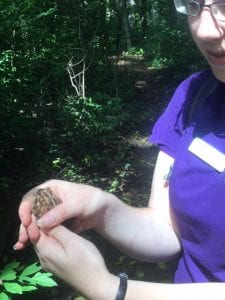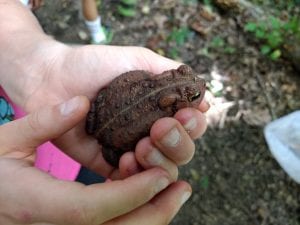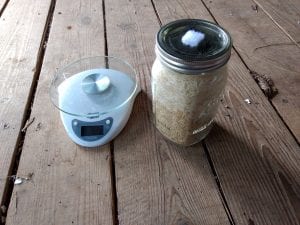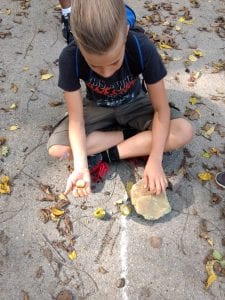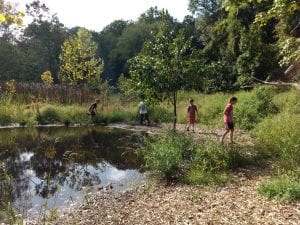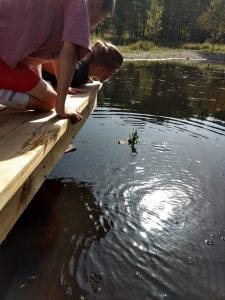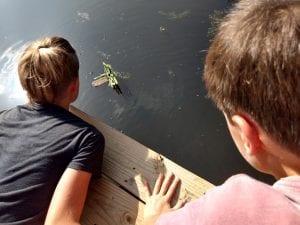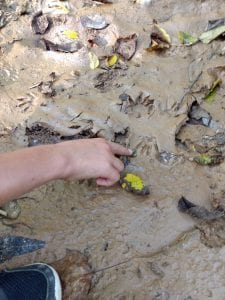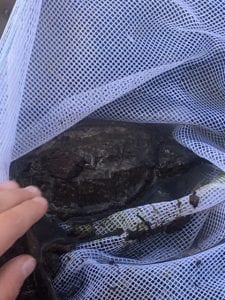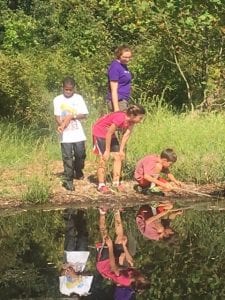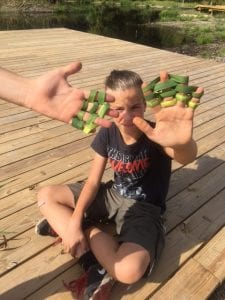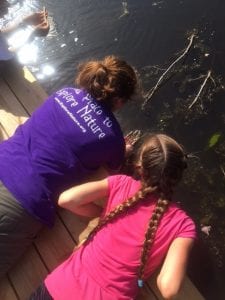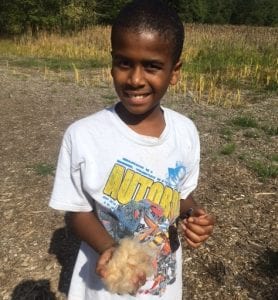What a great second week! This week we finished up our conversation about burrs and velcro from last week and did a really fun experiment velcro and we also created some really amazing rafts from natural materials. We started the day with our afternoon meeting circle in our new story ring just behind the outdoor classroom. We went around and everyone got the chance to share anything fun they did over the weekend and anything else they wanted to share before we began our day.
At the story circle we found some great looking white oak acorns and cracked a few open. They smelled interesting (I have no words to describe the smell!) and we even tasted them since white oak acorns can be tasted raw. There are far fewer bad tasting tannins in white oak acorns than in red oak acorns. No one was too fond of the flavor, except Lev who said he’s eaten them before and they weren’t too bad. We also identified some of the different leaves of the oak trees and made observations about the white oak leaves and how their tips are more rounded than red oak leaves and red oak leaves can be much larger, larger than your hand.
After matching acorns to leaves we continued along the trail but we didn’t get far because we found a very interesting toad! I picked it up so everyone could get a closer look because this wasn’t your average Eastern American Toad, this was a Fowler’s Toad! Fowler’s toads have fewer warts in each of their black patches on their back, generally 1-3 while Eastern American Toads have on average 3-5 warts per black patch. Otherwise they look almost identical! This wasn’t the only interesting toad we found, Eva found an Eastern American Toad on the same trail but it was a reddish color and it was lacking a lot of the characteristic black patches. Another cool find was the spider web Elias saw up in the trees. The way the sun was beaming through the forest with the water drops on the spider web really made it stand out.
We stopped at the gazebo for snacks and while we ate we listened to the plunk plunk of acorns, hickory and black walnuts as they fall from trees and hit the roof of the gazebo. After we had some sustenance we hiked down to the Ed Hut where we pulled out our journals and put in our interpretation of the burrs and velcro that we started to learn about last week. We taped burrs into our journal and then we thought about the discovery of velcro and we all started drawing dogs with burrs stuck to their fur! Noa drew a horse, James, Eva and I drew dogs and people even included things such as socks with burrs stuck to them, clever! We are seed carriers too. We then performed our velcro experiment. The purpose of the experiment was to see how much weight a specific size of velcro could hold. We had a small scale to measure our jar filled with rice and we timed each test for 10 seconds. Here are the results! We used a piece of velcro that was 2.5cm by 2 cm. We had one piece stuck to our jar of rice and the other attached to a lid of a smaller jar that we used to lift up the jar of rice. We started with 799g of rice (including the jar) which is the jar about half filled. Yes means it held for 10 seconds.
 Results: 799g = yes, 833g = yes, 917g = yes, 1,010g, 1,180g = yes! The velcro held with a full jar of rice and that is one small piece of velcro. We all predicted it wouldn’t hold with a full jar, it barely did though. We reduced the velcro size to 2cm by 2cm and the velcro DID NOT hold a full jar. That is some strong stuff!
Results: 799g = yes, 833g = yes, 917g = yes, 1,010g, 1,180g = yes! The velcro held with a full jar of rice and that is one small piece of velcro. We all predicted it wouldn’t hold with a full jar, it barely did though. We reduced the velcro size to 2cm by 2cm and the velcro DID NOT hold a full jar. That is some strong stuff!
After our experiment we planned to hike to the large pond with the intention to build rafts out of natural materials. We stopped under the Black Walnut tree and cracked open black walnuts with rocks and discovered the different colors inside, some were white, some were brown, some were moldy and some were full of maggots. Finally we reached the pond! We walked around the pond and explored and even found a baby snapping turtle, great eye Eva, wow! We got a quick look and then he/she swam to the middle of the pond, determined not to be discovered again. We also saw a lot of frogs jump into the pond.
We collected raft materials and used some twine as well to construct rafts. Elias built a raft with one large log and tied various materials to it, such as cattail and milkweed fluff and cattail leaves. I wove a raft of small sticks together using twine with a stick as a mast and a leaf at the top. Lev, James and Eva worked on a raft with a flat piece of wood that Lev carved a small hole in to fit a sail. The sail was made from woven cattail leaves. They first wove a really awesome basket that transformed for the small raft. We spoke about cattails briefly and learned their importance as a food source for native peoples and as a survival food. Even the inedible parts, like the leaves and cattail fluff served purposes, such as weaving mats for building walls and roofs and to sit and sleep on and the fluff was added to clothing and diapers. The gel hiding inside the cattail leaves can be used as a relief for sunburns and bug bites. Lev tried it out! It’s essentially an aloe vera replacement, cool huh?!
While floating our rafts we noticed the water striders and whirligig beetles on top of the water. I asked everyone to take a quick look and to think about how they sit on top of water since we’ll be learning a bit more about that on Week 3. One of the kids mentioned they did an experiment with a needle that they floated on water with the aid of toilet paper. This ability to float on water has a lot to do with water tension! Especially for things such as paper clips, needles and water striders that don’t displace water like boats do in order to float. After a quick look at the “slime” filling the pond, which is just a plant called algae (not sure the species), it was time to head back to Irvine. A garter snake slithered in front of us on our way back…nature’s way of giving us one last reminder about how amazing it is to spend time outside!
- Eastern American Toad?
- Velcro experiment
- Cracking open Black Walnuts
- Exploring the pond
- Making rafts
- Raccoon tracks
- Baby snapping turtle!
- Exploring the pond
- Cattail weaving
- Checking out the water striders and beetles
- Cattail seeds/fluff

